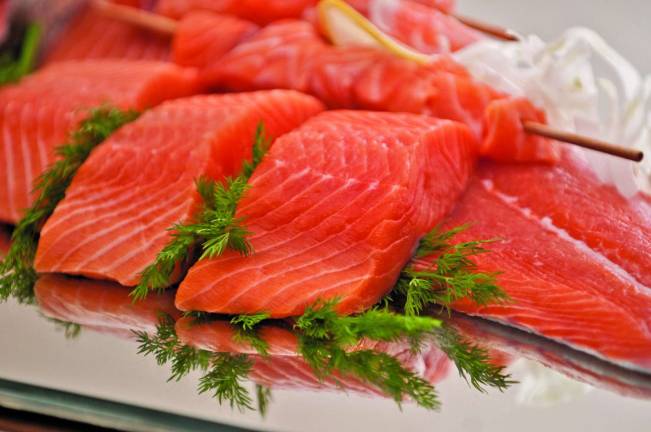When I buy salmon, should it be wild or farmed?

It’s been three years since salmon surpassed the chicken of the sea to become America’s favorite fish. But our seafood IQ still has some catching up to do.
Opt for wild, even if it means eating less
From a nutritional perspective, wild salmon is a far superior choice to farm-raised salmon. Wild salmon has about 30 percent fewer calories than farmed, and about half the fat. The type of fat is important as well. The fat in farmed salmon is about 30 percent saturated fat, whereas the fat in wild salmon is only about 10 percent saturated fat.
Wild salmon is also the better choice when comparing micronutrients. It’s higher in calcium, potassium, iron, and zinc. In addition, wild salmon has less sodium, and the kind of sodium it does contain is from all natural sea salt.
Wild salmon consume what they find in the natural environments of the ocean and the waters in which they live. Farm-raised salmon are fed an artificial diet consisting of grains, such as genetically-modified corn or soy, and synthetic feedings which are permitted for fish feed but not for human consumption. This disparity in diet contributes not only to the difference in taste between wild and farmed salmon, but also in those omega-3s you hear so much about.
Wild salmon are far richer in omega-3s, the essential fatty acid notoriously lacking in the western diet. The grain-based diet of farmed salmon produces a fish with a one-to-one ratio of omega-3s to omega-6s. Compare that to wild salmon, which generally has a ratio between six- and nine-to-one. The ratio in wild salmon correlates with decreased rates of heart disease and cancer.
Farm-raised salmon have higher rates of persistent organic pollutants. POPs are linked to higher rates of obesity, Type 2 diabetes and risk of stroke in women. While wild salmon also pick up pollutants and contaminants from unclean rivers and oceans, their levels are drastically lower.
One concern I often hear regarding wild salmon is cost. Nutritionally speaking, it is better to opt for wild salmon and consume it less frequently, than to choose farmed salmon. Particularly for children and women of childbearing age, wild salmon clearly stands as the healthier and safer choice. Look for wild salmon under the names Alaskan salmon and Sockeye salmon.
Bess Berger, RD, CDN is a registered dietitian and her practice is in Teaneck, NJ. BessbergerRD@gmail.com
Why choose? Buy both!
Both wild and farmed salmon are delicious, easy to prepare and incredibly good for you. Eating just 100 grams of salmon a week reduces the risk of death from coronary heart disease by 36 per cent. But if you are mulling your choices in the grocery store, here are some points to consider.
Farmed salmon is good for you.
Eating farmed Atlantic salmon helps prevent heart disease, lower cholesterol and blood pressure, boost your brain function and reduce the risk of cancer, stroke, depression, Alzheimer’s disease, arthritis, Crohn’s disease and asthma. It’s a great source of heart-healthy omega-3 polyunsaturated fatty acids. It contains no trans fats, is low in saturated fat, high in lean protein and one of the best natural sources of Vitamin D. The American, Canadian and International Heart and Stroke Foundations recommend eating fatty fish, like Atlantic salmon, at least twice a week.
Farmed salmon reduces pressure on wild salmon stocks.
Half of all seafood eaten by people globally is farmed. Wild fisheries cannot meet the growing global demand. According to the United Nations Food and Agriculture Organization, the world will face a seafood shortage of 50-80 million tons annually by 2030, without aquaculture. In fact, some wild salmon we eat are raised in hatcheries before being released into rivers. Farmed Atlantic salmon can help meet the growing global demand, taking the pressure off wild seafood stocks.
Farmed salmon is available fresh year-round and affordable.
Fresh wild salmon is available only at certain times of the year. Farmed Atlantic salmon is grown year-round and always available, so you can buy it fresh any time you like. It’s much less expensive than wild salmon too!
Farmed salmon is sustainably grown.
Atlantic Canadian salmon farmers are involved in third-party certification programs that ensure the highest quality salmon is produced. Atlantic salmon products can be traced back to the original farm and hatchery where the fish was raised, including records of what they ate and how the farmer cared for them. Atlantic salmon are raised without dyes or growth hormones, and they are not genetically modified. Whether wild or farmed, salmon is a fresh and safe choice!
Susan Farquharson is the executive director of the Atlantic Canada Fish Farmers Association.